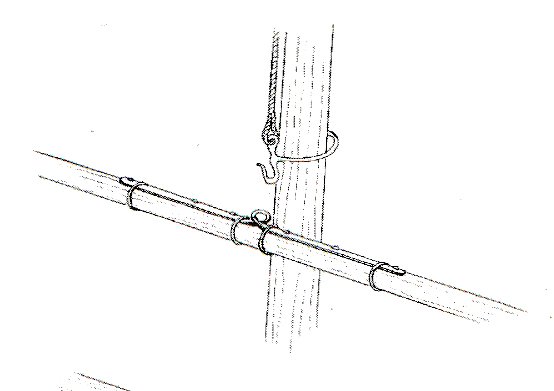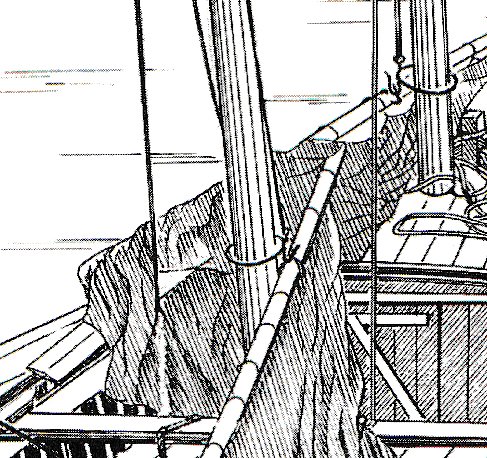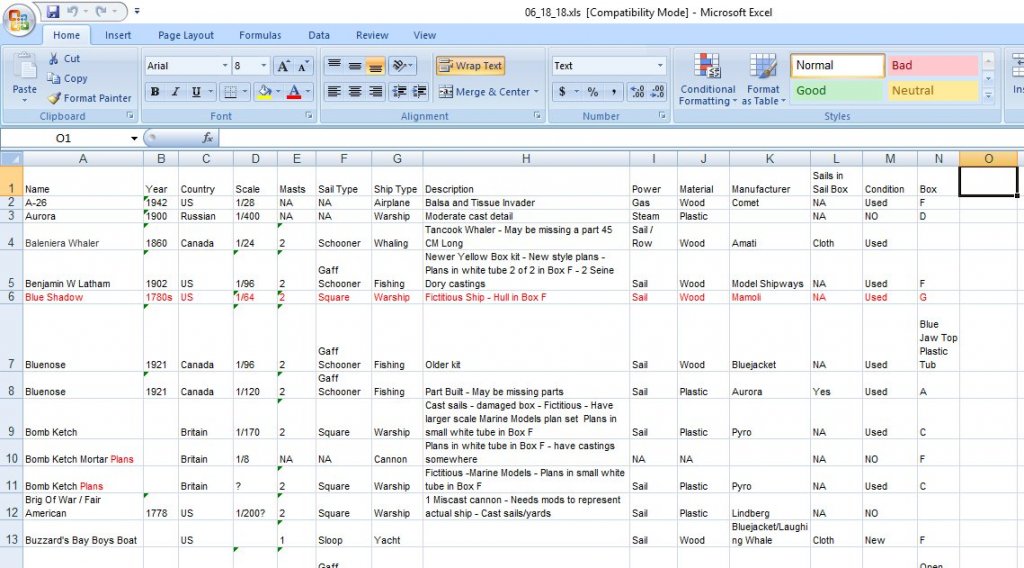-
Posts
2,937 -
Joined
-
Last visited
Content Type
Profiles
Forums
Gallery
Events
Everything posted by thibaultron
-

Shop Safety and Oops Repairs
thibaultron replied to BETAQDAVE's topic in Metal Work, Soldering and Metal Fittings
The more I get to know people, the more I like my cat! -

Shop Safety and Oops Repairs
thibaultron replied to BETAQDAVE's topic in Metal Work, Soldering and Metal Fittings
Hope it heals well. You might want to have that looked at, you may need a stitch or two. -
Welcome to the forum, and thank you for the service you provided!
-

My Spray Booth Construction
thibaultron replied to thibaultron's topic in Modeling tools and Workshop Equipment
Part 13 I finished installing the drop leaf today. I discovered that one of the supports was warped, and there was no way just adding a washer or two behind the hinge was going to let the leaf swing down fully. This shot shows the warped leaf, on the right, if you look closely. This is after I added the plywood washers (see below). I cut two hinge leg shaped washers from the last scrap piece of the plywood I built the booth out of. This shot is of the piece, after the washers were cut out. I’d already installed them before I thought to bring the camera out. I drilled out three holes in the washer. To match those holes in the hinge leg. I drilled these the same size as those in the hinge, as in a metal washer. Then I removed the hinge screws and installed the ply washers between the hinge and the side of the booth stand. You can see it in the middle upper of this picture. With the thick washer in place I had to trim the corner of the supports a bit more, to clear the bottom of the hinge leg. To capture the supports when the leaf is up, and prevent them from being accidentally knocked back to the folded position, I put in two #10-24 flat head screws into the table. A number 6 or 8 would have been sufficient, but I reused an existing hole, so had to go with the #10s. I counter sunk the table for the screws, and secured them underneath with a nut. The support is swung out and placed with the screws on either side of it, preventing it from being knocked in either direction. The leaf lifts up high enough for the support to clear the screws when positioning the support. The picture below is way out of focus, but you can make out the screws and nuts. I drilled a 3/8” hole in the folded in supports and the side of the stand, to clear the screws when the leaf is folded down. Adding the ply washers, of course, moved the edge of the table away from the booth by 3/8”. To keep little “things” from rolling down that slot, I added a ¾” square batten to the side of the booth, that seals the gap, with the leaf up. Adding it to the table would have been better, but there was not enough “meat” at the edge of the leaf to hold screws. I would have had to go with a wider batten, to attach it to the table. I chamfered the ends of the batten, so that there was not a sharp corner to hit. I still have to replace various hinge screws with #8-32 flat head machine screws, but I don’t have any, at the moment. -
Ordered some .008' copper wire, as well as .010 half hard and dead soft brass wire to make the hoist rings from. Here is a dimensioned drawing from the book. I hope that at least one of the wires will be strong enough to hold up after i make the fitting. It will not have to support the yard, That will be glued to the mast, as per the kit design, but it will have to withstand my fumble fingered installation! I estimated the sizes by measuring the actual diameter of the masts at the ring height, and used that as a basis for the other ones. CAD is great! The final diameters of the ring may be slightly larger than in the drawing, as the base of the masts are 0.115", and the ring should be able to rest on the deck, I would think. The drawing is quite busy, but it has all the dimensions I need.
-
Found this link on home 3D printing. he has 3 videos in the play list.
- 133 replies
-
- alert class
- tugboat
-
(and 1 more)
Tagged with:
-
Try water in the bottle instead of paint. Water is what they use at Badger to test every airbrush, before shipping. If it will not even spray water, there is something very wrong with it.
- 133 replies
-
- alert class
- tugboat
-
(and 1 more)
Tagged with:
-
I understand Badger also has great customer service, give them a call.
- 133 replies
-
- alert class
- tugboat
-
(and 1 more)
Tagged with:
-

My Spray Booth Construction
thibaultron replied to thibaultron's topic in Modeling tools and Workshop Equipment
Part 12 I added a drop down leaf to the side of the booth today. I used the end of the original table I cut off when I reduced the stand width to 24 inches. I used two strap hinges, one on each end. For now the hinges are screwed to the table. When I’m done I’ll install some machine screws in their place. The screws I put into the stand itself will stay, they are in the vertical corner stud inside. While I was adding the supports, I blocked the leaf up level, so I could position the parts with both hands. You can see, from the multiple extra holes, that this table has been used for a couple of other tasks in the past. Never throw anything out, until it is too small to use again! Also it drives the Admiral nuts. 🙂 If you look to the right bottom in the picture above, you will see a triangular end at the bottom of the stand. I removed these to make the table supports. At some time in the future I’ll replace them, but the only 3/8” plywood I had is a full 4x8 sheet of the same material, which would be better used on the outside of the shed. The only purpose they served was to keep me from tripping on the exposed stud. The extra stud length is needed to balance the fan that hangs off the back of the booth. Now the booth backs onto another desk, so there is no tripping hazard. I cut a relief on the corner of the triangular piece to clear the table hinge, and used two more straps to hang it. I also cut the end of this panel, as well as the one for the other side, so that the panels will sit flush against the side when the leaf is folded down. Yes the cut is ugly, opps! I placed the support hinges as shown so that the support will lay as close to the side of the stand as possible. The screw at the far end of the hinge will also be replaced with a machine screw, as there is no stud behind it. Right now the support panel is also screwed to the hinge. To strengthen this I’ll replace them with “T” nuts and machine screws. I don’t want the screws to rip out, when, not if, I fall against it! Never tempt Murphy! This is a shot of the table and support hinges on the inside of the assembly. On the other side, the front of the booth, the strap hinges stuck out past the vertical corner stud, so I took a hammer and bent them around and screwed the bent end to the inside of the stud (I didn’t think to get a picture of that). This is shot is the two supports folded in. Notice I did a better job trimming the end of the second support. Here is the whole thing folded down. I will have to add washers under the table hinges, to let the leaf hang freely, there is a bit of interference from the supports right now. And I managed to end up with the leaf sitting square to the booth when up. Next I have to add the blocks and pins to hold the supports in place, when the leaf is up. -
Well after 6 months of scanning, OCRing, spell checking in French, and translating electronically into English, I finally have a semi-readable version of the Sinagot book! I've reached a point in the shop renovations, that I can now do some actual modeling. Next I'm going to try making the hoist assembly for the spars. instead of attaching the hoist to the spar, there is a ring assembly that the spar is hung off of. This replaces jaws and parrel beads standardly used. Hoist Fitting_01.tif
-
Do you have a filter or water trap in the system? If so, it might be clogged. Do you get adequate flow through a different brush? Have you used this airbrush before? How big an area are you trying to cover? If you are trying to cover a large area, an external airbrush would be better. Internal mix brushes are made for detail work.
- 133 replies
-
- alert class
- tugboat
-
(and 1 more)
Tagged with:
-
Part 05 I did some more work on the workbench today. I decided to use the bottom shelf attached to the back of the legs to stiffen the bench. I was going to buy some plywood for this, but decided that the hardboard shelf would serve the purpose, and save some money. First I used the jig I made when I changed the rear shelf support holes, to drill new holes for attaching the former front shelf support to the upper part of the back legs. The support was fit just under the side panels. Next I trimmed the shelf to clear the side panels, and attached it with the bottom, even with the bottom of the lower support. I could have placed the shelf to fit all the way to the floor, but thought that some part will fall behind the workbench, then I would have to move it to get the part. This way I can still get behind the bench, if this happens. I only had 1 5/8” screws, while the two parts are only 1 ¼” thick, so I will have to go back with a cutoff wheel, to trim them on the footwell side. I will also have to get a handful of 2” 6-32 machine screws to re-attach the shelf brackets, I put in last time. 1 ½” screws were not quite long enough to fit thru the brackets, support, and back board.
-

Filler Blocks
thibaultron replied to olopa67's topic in Building, Framing, Planking and plating a ships hull and deck
The extruded foam does, however, have an issue with temperature changes! As the temperature changes, the foam expands and contracts, and when it re-expands after contracting, it does not return to its original size. It can end up, over time, as much as 2% smaller overall. Yes, this is documented in the manf. data sheets. This was pointed out in a Model Railroad forum, as many build their layouts out of this material. I measured some old sheets that I was given, and they are indeed 1/4" shorter than the original 96". These sheets came out of a Southern USA garage, and probably spent 20 years sitting in there, with the large temperature swings that would be expected. This would probably not be a big factor in our models, but I did want to make you aware of it. -
Harbor Freight Hardwood Workbench Kit bash Part 04 I added the shelf bracket braces to the bottom of the workbench. I had to use two of the pieces of the legs I cut off so that the brackets would meet the back cross piece. I used 3 inch deck screws to attach the leg pieces to the side cross braces. I think I’ll buy a handful of 3 ½” screws to replace them, as the legs are 2” thick, and I want more than 1” of engagement. I’ll flip the bench and replace the 3” screws I used to attach the feet, also. I used 1 5/8” drywall screws to attach the bracket to the side pieces. The screws in the corner are driven in at an angle to also go into the leg itself. To attach the bracket to the rear crosspiece, I used #6 machine screws and nuts, as that part is only ¾” thick. On the side shown in the picture I was able to get 2 machine screws in the corner, by angling the holes a little away from the nuts in the crosspiece. On the other side the bracket was not as well placed, and I only got one screw in. I may cut the tenons off the added pieces later. I tested the work bench and will follow Dave’s suggestions of adding the former front cross brace to the back, and also adding a piece of 3/8” ply across the back of the rear legs. I’ll probably put the front brace at the top of the plywood, and screw the ply into both braces. The workbench does not move much side to side, but may after a few years of use, so I’ll fix that problem now.
-

My Spray Booth Construction
thibaultron replied to thibaultron's topic in Modeling tools and Workshop Equipment
I removed the triangular plywood braces at the bottom of the booth stand, at 24" wide my feet kept hitting them. I'll put in a couple of metal shelf brackets in their place, like I did for my workbench. I added a removable shelf to the base to store the air compressor, when the booth is not being used. I also added a couple of wood blocks to protect the regulator, now that the table does not stick out of that side. The vertical block catches the corner of the wall, so I don't push the regular into it. The corner is recessed a bit as the sliding doors sit on that side of the wall. -
Something that has not been mentioned, is cutting oil, at least for metals. Any time you are cutting threads in metal use a good cutting oil. For steel, brass, etc. a regulator type will work. For aluminum, use a dedicated AL cutting fluid. When tapping after the tap has been started, turn it a quarter or half turn, then back it out a quarter turn, go back until it bites and repeat. Remove and clean the tap frequently! For tapping with small taps, a block drilled with the clearance sized drill, set on the part, can be used to keep the tap perpendicular. When tapping on the lathe, the chuck, or the chuck with the chuck key inserted can be used to turn the part by hand. For cutting external threads, the die can be held against the tailstock ram, and pressed to the end of the part. This keeps the die perpendicular until the thread is started. Lock the lathe and turn the die by hand until the thread is started, then back off the tailstock, and either continue turning the die, or unlock the lathe and hold the die while turning the part. Remember, taking time cutting the thread is much better than breaking the tap, and m, having to make a new part!
About us
Modelshipworld - Advancing Ship Modeling through Research
SSL Secured
Your security is important for us so this Website is SSL-Secured
NRG Mailing Address
Nautical Research Guild
237 South Lincoln Street
Westmont IL, 60559-1917
Model Ship World ® and the MSW logo are Registered Trademarks, and belong to the Nautical Research Guild (United States Patent and Trademark Office: No. 6,929,264 & No. 6,929,274, registered Dec. 20, 2022)
Helpful Links
About the NRG
If you enjoy building ship models that are historically accurate as well as beautiful, then The Nautical Research Guild (NRG) is just right for you.
The Guild is a non-profit educational organization whose mission is to “Advance Ship Modeling Through Research”. We provide support to our members in their efforts to raise the quality of their model ships.
The Nautical Research Guild has published our world-renowned quarterly magazine, The Nautical Research Journal, since 1955. The pages of the Journal are full of articles by accomplished ship modelers who show you how they create those exquisite details on their models, and by maritime historians who show you the correct details to build. The Journal is available in both print and digital editions. Go to the NRG web site (www.thenrg.org) to download a complimentary digital copy of the Journal. The NRG also publishes plan sets, books and compilations of back issues of the Journal and the former Ships in Scale and Model Ship Builder magazines.





